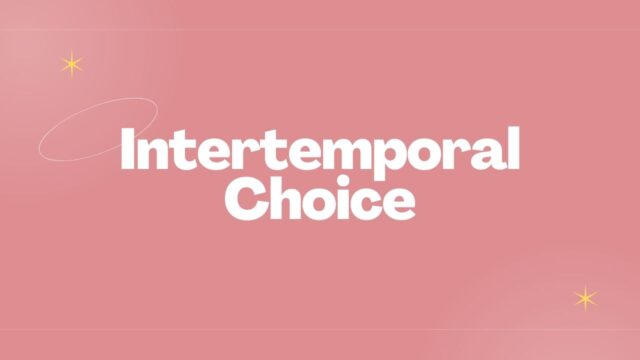
What is Intertemporal Choice
Intertemporal choice is the process of making decisions about events that will take place in the future. Individuals often face intertemporal choices when deciding whether to save or spend money, as well as when considering decisions with long-term consequences, such as whether to smoke cigarettes or eat healthy foods. The study of intertemporal choice investigates how people make these types of decisions, as well as the factors that influence their choices.
Discounting, which is the process of reducing the value of future rewards, is one important factor that affects intertemporal choice. For example, people are more likely to choose immediate gratification over delayed satisfaction if the rewards are discounted heavily. Research on intertemporal choice can help us to understand why people make certain decisions and how we can encourage them to make better choices for their future selves.
Why do people make Intertemporal Choices
People make intertemporal choices when they have to trade off between two or more options that have different consequences at different times. For example, someone might choose to go to college now even though it means sacrificing some immediate gratification, because they believe that the long-term benefits of a college education will outweigh the costs. People make intertemporal choices all the time, and the factors that influence those choices can vary from person to person.
Some people might be more risk-averse and prefer the security of a guaranteed payoff in the future, while others might be more impatient and willing to trade off some future rewards for immediate gratification. Ultimately, the intertemporal choices people make depend on their individual preferences and objectives.
How to make Intertemporal Choices
There are steps that people can take to make more thoughtful intertemporal choices. One approach is to use a cost-benefit analysis, which involves weighting the costs and benefits of different choices over different time periods. Another approach is to use mental accounting, which involves categorizing different choices as being either short-term or long-term. By taking the time to carefully consider their options, people can make more informed decisions about how to best allocate their resources.
The benefits of making Intertemporal Choices
Making intertemporal choices can be difficult, because it requires us to think about the long-term implications of our actions. However, there are some benefits to making intertemporal choices. First, it can help us achieve our goals. If we want to retire comfortably, we need to start saving early. Second, making intertemporal choices can improve our health and well-being. For example, choosing to exercise today can lead to better health in the future. Finally, making intertemporal choices can help us avoid regret. If we make a choice that does not pan out, we may regret not making a different choice. However, if we make the best choice given the information available to us at the time, we are less likely to experience regret.
The drawbacks of making Intertemporal Choices
There are a number of drawbacks to making intertemporal choices. First, we may discount the future too much, leading us to undervalue long-term rewards. This can cause us to make short-sighted decisions that have negative consequences down the road. Second, our preferences may change over time, making it difficult to predict how we will feel about a particular choice in the future. Finally, we may simply not have enough information about the future to make an informed decision. This uncertainty can lead us to make choices that we later regret.
Tips for making Intertemporal Choices
Here are some tips that may help:
1. Consider your long-term goals. What do you want to achieve in life? What kind of person do you want to be? Keeping your long-term goals in mind can help you make better intertemporal choices.
2. Try to think objectively about the future. It can be difficult to predict how we will feel in the future, but it is important to try. When making an intertemporal choice, ask yourself how likely you are to still be happy with your decision in a month, a year, or five years from now.
3. Be mindful of opportunity costs. Every choice has an opportunity cost, which is the value of the next best alternative that you give up when you make a decision.
The role of Emotions in Intertemporal Choice
Emotions play a significant role in intertemporal choice, which refers to the idea of making choices between two options that result in different payoffs at different times. For example, when faced with the choice between going out to eat now or cooking at home and eating later, we must weigh the immediate gratification of a delicious meal against the long-term benefits of saving money.
Emotions can influence this decision-making process in a number of ways. First, they can help us to focus on either the short-term or the long-term consequences of our choices. Second, they can affect our perceptions of how desirable each option is. And finally, they can lead us to discount future rewards relative to present rewards. In other words, emotions can have a significant impact on the decisions we make about when to consume goods and services.
The future of Intertemporal Choice
Many experts believe that the future of Intertemporal Choice (ITC) lies in the development of new models that can more accurately predict human behavior. Currently, the most popular models used to make ITC decisions are based on assumptions that are not always realistic, such as perfect foresight and self-control.
As a result, these models often produce suboptimal outcomes. By contrast, newer models that take into account cognitive biases and other real-world factors are able to generate more accurate predictions. In addition, these models are often easier to use, since they require less complex calculations. As ITC decision-making becomes more commonplace, it is likely that more organizations will adopt these newer, more user-friendly models.


































